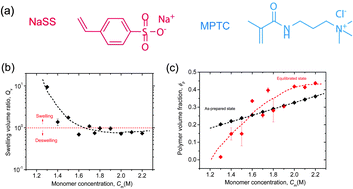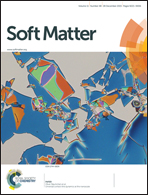Molecular structure of self-healing polyampholyte hydrogels analyzed from tensile behaviors†
Abstract
Recently, charge balanced polyampholytes (PA) have been found to form tough and self-healing hydrogels. This class of physical hydrogels have a very high equilibrated polymer concentration in water (ca. 40–50 wt%), and are strongly viscoelastic. They are synthesized by random copolymerization of equal amounts of oppositely charged monomers at a high concentration, followed by a dialysis process of the small counter-ions and co-ions in water. The randomly distributed, opposite charges of the polymer form multiple ionic bonds of intra- and inter-chains with strength distribution. The strong inter-chain bonds, stabilized by topological entanglement, serve as quasi-permanent crosslinks, imparting the elasticity, while the weak bonds, both inter- and intra-chains, reversibly break and re-form to dissipate energy to toughen the materials. In this work, we intend to clarify the structure of the physical PA hydrogels from the tensile behaviors of the PA hydrogels. To clarify the structure and its formation mechanism, we analysed the tensile behaviors of the samples before and after the dialysis. We separated the quasi-permanent crosslinking of strong inter-chain bonds and the dynamic crosslinking of weak inter-chain bonds by using a combined model that consists of the Upper Convected Maxwell model and the Gent strain hardening model. The model fitting of the tensile behaviors extracts quantitative structural parameters, including the densities of weak and strong inter-chain bonds and the theoretical finite extensibility of polymer chains. Based on the fitting results of the combined model, the structural parameters of partial chains at a fixed observation time, including the Kuhn number, Kuhn length, and chain conformation, are determined using the scaling theory. The effects of monomer concentration at preparation, the effect of dialysis and the initial strain rate on the dynamic structure of PA gels, are discussed based on these analyses.


 Please wait while we load your content...
Please wait while we load your content...